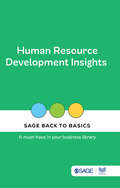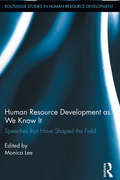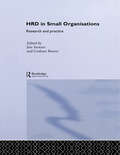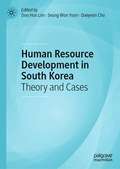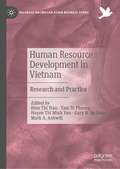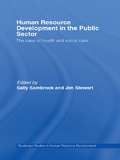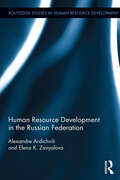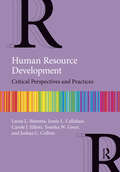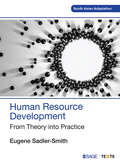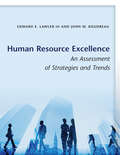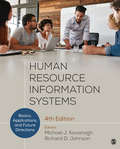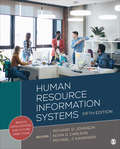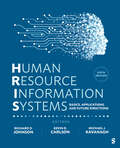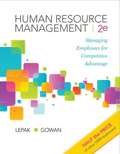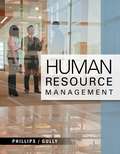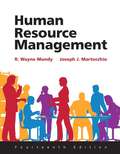- Table View
- List View
Human Resource Development Insights (SAGE Back to Basics)
by SAGE Publications India Pvt. LtdHR can transform organizations only if it transforms HR. Human Resource Development Insights is a pivotal source of information on implementing new ways to stimulate growth within an organization. Based on groundbreaking research, this book provides compelling theory and practical tools to create alignment between people, strategy and systems. Covering a range of topics such as recruitment, competency mapping, performance management, training and learning, and team effectiveness scale, the book is an ideal reference for HR practitioners seeking content on implementing new competencies in the workforce and achieving overall organizational development. SAGE Back to Basics is a distilled compilation of proven and timeless ideas and best practices for new-age and experienced leaders alike. The hand-picked collection of books—on management, leadership, entrepreneurship, branding and CSR—offer advice from management experts whose knowledge and research has impacted and shaped business and management education. Other books in the series: Timeless Leadership | Advertising and Branding Basics | Leadership Lessons from Dr Pritam Singh | Corporate Social Responsibility in India | Basics of Entrepreneurship | Ideate, Brainstorm, Create | Building Professional Competencies | Timeless Management | Soft Skills for Workplace Success
Human Resource Development as We Know It: Speeches that Have Shaped the Field (Routledge Studies in Human Resource Development)
by Monica LeeThe field of Human Resource Development has developed largely through academics, scholars and reflective practitioners from across the world coming together. Many people link memorable keynote speeches to changes in their research, practice, career path or even life view. Good keynote speeches are a forthright statement of the expert’s view and thus are often not published. Now that HRD is maturing there is a need to recapture some of those earlier moments – both as a form of archive, and also to shed light on the path that has been followed. Twenty-two speeches seminal to the field of HRD are included in this volume. These speeches are milestones along the path of the development of the field; as well as reconstructing their speech, the contributors have also located it within the time it was given and commented on how the field has developed since. This book is a resource, not only as an archive and for those who wish to relive their pivotal moments, but also for anyone interested in the development of HRD as a discipline. This unique approach provides an exciting and engaging way to reflect on cutting edge issues in the academic and practitioner world of HRD!
Human Resource Development in Small Organisations: Research and Practice
by Jim Stewart Graham BeaverIn its description and analysis of the current context of research and practice of HRD in small organizations, this collection of essays provides a comprehensive and critical evaluation of current approaches. This evaluation leads to an exploration of a number and range of HRD methods as they are applied in the small organization context and provid
Human Resource Development in South Korea: Theory and Cases
by Doo Hun Lim Seung Won Yoon Daeyeon ChoThis edited book covers major trends, notable distinctions, and the challenges and needs for preparing future HRD activities in South Korea. It consists of three major sections: national and social issues of HRD, sector perspectives on HRD, and contemporary issues and trends. To cover contemporary trends and future issues, authors examine topics in diverse areas, such as the application of data analytics for HRD, action learning trends, and psychological and work climate issues affecting performance. Through theory and cases, this book will show how HRD can be successful at the organizational, industrial, and societal levels as well as the future needs required to further advance HRD in the nation.
Human Resource Development in Vietnam: Research and Practice (Palgrave Macmillan Asian Business Series)
by Mark A. Ashwill Gary N. McLean Hien Thi Tran Tam To Phuong Huyen Thi Minh VanDespite recent high GDP growth rates, Vietnam remains a developing country in need of developing human resources (HR) of both genders. This can be done through education, workplace training, corporate social responsibility, policies for gender equality, support for entrepreneurship, and other practices and policies. Yet, national human resource development (NHRD) is a relatively new concept in Vietnam. This edited volume highlights the importance of HR, HRD, and NHRD, enabling Vietnam to experience sustainable growth and become a modern industrial country. It examines the positive changes effected by HRD considering Vietnam’s unique historical, political, economic, and cultural contexts. This book offers scholars and practitioners an indigenous HRD approach and discusses implications for future research and practices.
Human Resource Development in the Public Sector: The Case of Health and Social Care (Routledge Studies in Human Resource Development)
by Jim Stewart Sally SambrookAcross Europe and the world, countries are attempting to develop their health and social policies and practices to address the global challenge of increasing demand and pressurized supply, created by ageing populations, emerging technologies and finite resources (financial and human). This text provides examples of attempts to develop HRD practices in health and social care contexts within France, Ireland, The Netherlands, Romania, Russia, the UK and the USA. Thus, the book is European and international in both scope and appeal.
Human Resource Development in the Russian Federation (Routledge Studies in Human Resource Development)
by Alexandre Ardichvili Elena ZavyalovaUnlike Brazil, India, or China, prior to the beginning of market-oriented reforms in early 1990s, Russia maintained a high level of human capital and possessed a highly developed system of vocational education, continuous education, and management development institutions sponsored by the government. However, after the beginning of the market reforms many state-sponsored programs were disbanded and individual enterprises and newly emerging private educational institutions found themselves in a position of having to provide training and professional development services for future and current employees. Both government-level policies in support of HRD and enterprise-level HRD systems have emerged fairly recently in the Russian Federation, and are still in a stage of change and development. This book provides an in-depth analysis of the current state of HRD in the Russian Federation. It covers country-level policies, organizational-level programs and strategies, and individual-level educational and training efforts. While the study is focused on Russia, its conclusions will be of value to scholars, students, and practitioners examining similar issues surrounding the emergence and development of HRD systems in emerging countries. Furthermore, the authors’ framework for analyzing HRD on multiple levels and across various parts of the adult and vocational education and development systems offers a unique and important contribution to the theoretical debate on comparative educational systems outside the HRD and HRM communities.
Human Resource Development: Critical Perspectives and Practices
by Laura L. Bierema Joshua C. Collins Jamie L. Callahan Carole J. Elliott Tomika W. GreerHuman Resource Development: Critical Perspectives and Practices is a landmark textbook on HRD scholarship and practice and is a significant departure from the standard HRD texts available. Based on Bierema and Callahan’s framework for critical human resource development, this book develops an understanding of HRD that addresses both key and contested issues of practice associated with relating, learning, changing, and organizing for organizations. This book covers the basic tenets of HRD, interrogates the dominant paradigms and practices of the field, teaches readers how to critically assess HRD practices and outcomes, and provides critical alternatives. The text also addresses HRD as a contested field and the importance for HRD professionals to reflect on their values, maintain their sanity, and retain their employment while attempting to do this difficult work that serves multiple stakeholders. The text weaves in Points to Ponder, Case in Point, and Tips & Tools features and exercises, giving readers an insight into HRD issues across the globe. This critical text offers an exciting alternative to the instrumentalist, managerialist, and masculine perspective of other books. Designed for students and practitioners, this textbook will be essential reading for upper-level courses on human resource development, human resource management, and adult education.
Human Resource Development: From Theory into Practice
by Eugene Sadler-SmithCombining theoretical rigor, practical relevance and pedagogical innovation, Human Resource Development: From Theory into Practice is an essential resource for students working towards a career in human resource development (HRD), human resource management (HRM), occupational and organizational psychology, and related areas of business management and organization. Key features: • Aligns with the CIPD Professional Standards and the CIPD’s Level 7 Diploma in Learning and Development. • Covers all the basics in the fundamentals of HRD theory and practice, as well as cutting-edge topics such as the e-learning, ‘hybrid learning’, neuroscience and learning, ‘learning ecosystems’, and the ‘new learning organization’ science of learning. • Follows a unique framework based on the a distinction between ‘micro-HRD’, which zooms-in on the fine detail, meso, and ‘macro-HRD’, which zooms-out to look at the bigger picture. • Includes a rich array of research insights, case studies and examples from a wide range of contexts. • Offers a variety of learning features, including ‘perspectives from practice’ and ‘in their own words’, which help to bridge the gap between theory and practical application. This up-to-date and authoritative textbook is accompanied by a comprehensive instructor’s manual and PowerPoint slides to support lecturers in their teaching.
Human Resource Development: From Theory into Practice
by Eugene Sadler-SmithCombining theoretical rigor, practical relevance and pedagogical innovation, Human Resource Development: From Theory into Practice is an essential resource for students working towards a career in human resource development (HRD), human resource management (HRM), occupational and organizational psychology, and related areas of business management and organization. Key features: • Aligns with the CIPD Professional Standards and the CIPD’s Level 7 Diploma in Learning and Development. • Covers all the basics in the fundamentals of HRD theory and practice, as well as cutting-edge topics such as the e-learning, ‘hybrid learning’, neuroscience and learning, ‘learning ecosystems’, and the ‘new learning organization’ science of learning. • Follows a unique framework based on the a distinction between ‘micro-HRD’, which zooms-in on the fine detail, meso, and ‘macro-HRD’, which zooms-out to look at the bigger picture. • Includes a rich array of research insights, case studies and examples from a wide range of contexts. • Offers a variety of learning features, including ‘perspectives from practice’ and ‘in their own words’, which help to bridge the gap between theory and practical application. This up-to-date and authoritative textbook is accompanied by a comprehensive instructor’s manual and PowerPoint slides to support lecturers in their teaching.
Human Resource Development: From Theory into Practice
by Eugene Sadler-SmithAn immersive textbook that offers readers a comprehensive and detailed introduction to HRD that is theory-based, evidence-driven and practically oriented This textbook combines theoretical rigour and pedagogical innovation to give students and teachers alike an accessible guide to human resource development and its fundamental theories and practices. The book reflects the author's firm belief that learning offers the best competitive advantage and is thus designed to train students interested in HRD into industry-ready professionals. Human Resource Development will guide its readers on how to maximize employees' potential using systematic and systemic approaches to drive individual and organizational performance. Key Features: • Analytical approach to the subject with a checklist framework in each chapter that presents the contents systematically • Follows a unique framework based on the distinction between 'micro-HRD', which zooms-in on the fine details, and 'macro-HRD', which zooms-out to look at the bigger picture • Includes a rich array of research insights, case studies and examples from a wide range of contexts • Covers cutting-edge topics such as e-learning, 'hybrid learning', neuroscience and learning, 'learning ecosystems', and the 'new learning organization' science of learning
Human Resource Development: Talent Development (Seventh Edition)
by Jon M. WernerHUMAN RESOURCE DEVELOPMENT is a comprehensive text for undergraduate and graduate courses that prepare students to train and develop people. As such, the book covers the entire field of HRD (as defined by the American Society for Training and Development's competency study), from orientation and skills training, to career and organizational development. HUMAN RESOURCE DEVELOPMENT provides a clear understanding of the concepts, processes, and practices that form the basis of success and shows how concepts and theory can and have been put into practice in a variety of organizations. This textbook focuses on the shared role of line management and human resource specialists in HRD and also reflects the current state of the field, blending real-world practices with up-to-date research.
Human Resource Excellence: An Assessment of Strategies and Trends
by Edward E. Lawler III John W. BoudreauAs a field, human resources has been slow to evolve, despite a great need and opportunity for change. Human Resource Excellence delivers the newest findings about what makes HR successful and how it can add value to today's organizations. Tracing changes in a global sample of firms across the US, Europe, and Asia, this landmark volume provides an international benchmark against which to measure a company's HR practice. For over twenty years, USC's Center for Effective Organizations has conducted the definitive longitudinal study of the human resource management function. Analyzing new data every three years, the Center charts changes in HR and offers guidance on how human resource professionals can drive firm performance. In this latest survey, Edward E. Lawler III and John W. Boudreau conclude that HR is most powerful when it plays a strategic role, makes use of information technology, and has tangible metrics and analytics. Their insights offer an essential understanding of HR's changing role in strategy, big data, social and knowledge networks, and the gig economy.
Human Resource Information Systems: Basics, Applications, and Future Directions
by Dr Michael J. Kavanagh Mohan Thite Dr Richard D. JohnsonHuman Resource Information Systems: Basics, Applications, and Future Directions, Third Edition is a cross-disciplinary book that provides a thorough introduction to the field of Human Resource Information Systems (HRIS), a combination of two major management fields that impact the competitive advantage of companies—human resources and information systems. Unlike other HRIS textbooks that overwhelm students with technical info and jargon, Michael J. Kavanagh and Richard D. Johnson offer a balanced approach in dealing with HR and IT/IS issues by drawing from experts in both areas.
Human Resource Information Systems: Basics, Applications, and Future Directions
by Dr Michael J. Kavanagh Dr Richard D. JohnsonHuman Resource Information Systems, edited by Michael J. Kavanagh and Richard D. Johnson, is a one-of-a-kind book that provides a thorough introduction to the field of Human Resource Information Systems (HRIS) and shows how organizations today can leverage HRIS to make better people decisions and manage talent more effectively. Unlike other texts that overwhelm students with technical information and jargon, this revised Fourth Edition offers a balanced approach in dealing with HR issues and IT/IS issues by drawing from experts in both areas. Numerous examples, best practices, discussion questions, and case studies make this the most student-friendly and current text on the market. New to This Edition A new chapter on social media explores how organizations can use social networks to recruit and select the best candidates. A new HRIS Expert feature spotlights real-world practitioners who share best practices and insights into how chapter concepts affect HR professions. New and expanded coverage of key trends such as information security, privacy, cloud computing, talent management software, and HR analytics is included.
Human Resource Information Systems: Basics, Applications, and Future Directions
by Richard D. Johnson Kevin D. Carlson Michael J. KavanaghHuman Resource Information Systems: Basics, Applications, and Future Directions is a one-of-a-kind book that provides a thorough introduction to the field of Human Resource Information Systems (HRIS) and shows how organizations today can leverage HRIS to make better people decisions and manage talent more effectively. Unlike other texts that overwhelm students with technical information and jargon, this revised Fifth Edition offers a balanced approach in dealing with HR issues and IT/IS issues by drawing from experts in both areas. It includes the latest research and developments in the areas of HRIS justification strategies, HR technology, big data, and artificial intelligence. Numerous examples, best practices, discussion questions, and case studies, make this book the most student-friendly and current text on the market. Included with this title: The password-protected Instructor Resource Site (formally known as SAGE Edge) offers access to all text-specific resources, including a test bank and editable, chapter-specific PowerPoint® slides.
Human Resource Information Systems: Basics, Applications, and Future Directions
by Richard D. Johnson Kevin D. Carlson Michael J. KavanaghHuman Resource Information Systems: Basics, Applications, and Future Directions is a one-of-a-kind book that provides a thorough introduction to the field of Human Resource Information Systems (HRIS) and shows how organizations today can leverage HRIS to make better people decisions and manage talent more effectively. Unlike other texts that overwhelm students with technical information and jargon, this revised Fifth Edition offers a balanced approach in dealing with HR issues and IT/IS issues by drawing from experts in both areas. It includes the latest research and developments in the areas of HRIS justification strategies, HR technology, big data, and artificial intelligence. Numerous examples, best practices, discussion questions, and case studies, make this book the most student-friendly and current text on the market. Included with this title: The password-protected Instructor Resource Site (formally known as SAGE Edge) offers access to all text-specific resources, including a test bank and editable, chapter-specific PowerPoint® slides.
Human Resource Information Systems: Basics, Applications, and Future Directions
by Kevin D. Carlson Michael J. Kavanagh Richard David JohnsonHuman Resource Information Systems: Basics, Applications, and Future Directions is a one-of-a-kind book that provides a thorough introduction to the field of Human Resource Information Systems (HRIS) and shows how organizations today can leverage HRIS to make better people decisions and manage talent more effectively. Unlike other texts that overwhelm students with technical information and jargon, this revised Sixth Edition offers a balanced approach to dealing with HR issues and IT/IS issues by drawing from experts in both areas. Authors Richard D. Johnson, Kevin D. Carlson, and Michael J. Kavanagh cover the latest research and developments in information security, artificial intelligence, cloud computing, social media, and HR analytics. Numerous examples, best practices, discussion questions, and case studies, make this book the most student-friendly and current in the market.
Human Resource Information Systems: Basics, Applications, and Future Directions
by Kevin D. Carlson Michael J. Kavanagh Richard David JohnsonHuman Resource Information Systems: Basics, Applications, and Future Directions is a one-of-a-kind book that provides a thorough introduction to the field of Human Resource Information Systems (HRIS) and shows how organizations today can leverage HRIS to make better people decisions and manage talent more effectively. Unlike other texts that overwhelm students with technical information and jargon, this revised Sixth Edition offers a balanced approach to dealing with HR issues and IT/IS issues by drawing from experts in both areas. Authors Richard D. Johnson, Kevin D. Carlson, and Michael J. Kavanagh cover the latest research and developments in information security, artificial intelligence, cloud computing, social media, and HR analytics. Numerous examples, best practices, discussion questions, and case studies, make this book the most student-friendly and current in the market.
Human Resource Information Systems: Basics, Applications, and Future Directions
by Richard Johnson Michael KavanaghHuman Resource Information Systems, edited by Michael J. Kavanagh and Richard D. Johnson, is a one-of-a-kind book that provides a thorough introduction to the field of Human Resource Information Systems (HRIS) and shows how organizations today can leverage HRIS to make better people decisions and manage talent more effectively. Unlike other texts that overwhelm students with technical information and jargon, this revised Fourth Edition offers a balanced approach in dealing with HR issues and IT/IS issues by drawing from experts in both areas. Numerous examples, best practices, discussion questions, and case studies make this the most student-friendly and current text on the market. New to This Edition A new chapter on social media explores how organizations can use social networks to recruit and select the best candidates. A new HRIS Expert feature spotlights real-world practitioners who share best practices and insights into how chapter concepts affect HR professions. New and expanded coverage of key trends such as information security, privacy, cloud computing, talent management software, and HR analytics is included.
Human Resource Management
by Dr Pawan Budhwar Jonathan Crawshaw Ann DavisThis new text treats international, strategic and contemporary issues as central to the study and practice of Human Resource Management. Covering the core curriculum, this book provides all the knowledge and tools you need to get the best possible grades and achieve career success after university. Key Features: Skills and employability focus will help you to develop the key transferable skills valued by graduate employers Debating HRM boxes encourage critical analysis and debate International and cross-cultural cases and discussion will prepare you for the global workplace Contemporary and strategic issues are introduced early on, underpinning the HRM functions Chapters on SMEs and the not-for-profit and voluntary sectors will ensure that your knowledge and skills can be applied in a range of organisational settings Mapped to the CIPD's learning outcomes but equally suitable for non-specialist students Journal articles, a glossary, podcasts and other resources are available on the book's website at www.sagepub.co.uk/crawshaw
Human Resource Management
by Gary DesslerFor courses in Management. Human Resource Management provides readers with the daily tools and skills they need to function as successful managers--in both human resources and business in general. With a practical approach, the text explores the evolution of the field, highlighting the introduction of revolutionary new technologies and social media platforms such as LinkedIn and cloud computing. The Fifteenth Edition focuses on the positive impacts technology has had on the HR field. The ability to vet potential employees on the Internet shifts more HR responsibilities to managers, leaving HR departments with more time to carry out strategic, long-term endeavors for boosting employee performance and engagement. With a heavy focus on emerging industry trends, the text prepares readers with everything they need to be successful managers and HR personnel in the 21st century.
Human Resource Management
by Gowan LepakThis book seeks to help students understand the dynamic and exciting environment of human resources (HR) management and the complex decisions that all managers must make when managing employees.
Human Resource Management
by Jean Phillips Stanley GullyThe focus of HUMAN RESOURCE MANAGEMENT is on developing students' personal and managerial skills by (1) Helping students understand the role of HR in organizational effectiveness as well as their personal career success; (2) Enabling students to understand how to flexibly apply the HR concepts that are appropriate for different problems or situations, and how HR both influences and is influenced by business strategy; and (3) Creating an understanding of the HR context by embedding the important concepts of ethics, diversity, competitive advantage, and the global context throughout the book. This highly readable book will help students understand how to use HR to hire, develop, motivate, and retain the right people and bring out the best in employees to execute the company's business strategy. It is intended for anyone who is or who might become a manager or an HR professional. By developing readers' competence and confidence in using important HR skills, this book will help anyone become a more effective manager through a better use of HR tools. Because most students learn more easily when they see the applicability of concepts to real life situations, HUMAN RESOURCE MANAGEMENT provides numerous current company examples throughout the book. A book-long integrated case supplemented with interactive online videos develops students' personal skills and gives them some experience in applying various HR concepts. The case and videos reinforce the relevance of the textbook material and make the content even more understandable.
Human Resource Management
by Joseph J. Martocchio R. Wayne MondyHuman Resource Management addresses the study of HR in a realistic, practical, and stimulating manner. Examples of how HR management is practiced in the real world and the relationship between various HR topics are interwoven throughout the text, giving students a thorough introduction to the field based on sound theoretical concepts and practice. The Fourteenth Edition reveals HR's strategic importance to management and the overall health of an organization. The text also addresses the ongoing shrinkage of internal HR departments as many companies shift towards HR outsourcing, HR shared service centers, and professional employer organizations. Students should walk away with an appreciation for how the HR profession continues to shed its administrative image and while focusing on mission-oriented activities.
